Understanding the Principles of Gear Effect
Jeff Summitt Discusses The Ins and Outs of Gear Effect
Have you ever wondered why the faces on drivers, fairway woods and even some hybrids are not flat like an iron? Well if you haven’t noticed, take a quick look. There is a certain amount of curvature to the face of a club which is considered a positive design feature. Why? Before we get to that point, let us understand the anatomy of the club first along with some quick definitions.
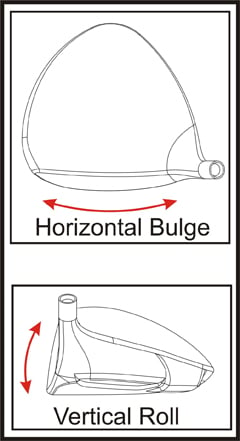 Bulge
Bulge
There are typically two radii on the face. The first one shown is called horizontal bulge which is the curvature in the horizontal plane extending from the heel to the toe.
Roll
The second radius is vertical roll, which the curvature is in the vertical plane from the sole of the club to the topline.
The units of measurement are expressed in inches its radius. A popular dimension amongst drivers and fairways are produced with a 10 inch bulge and 10 inch roll. To provide an explanation, imagine a circle 20 inches in diameter (10 inch radius). The arc of that circle would have the same curvature for the length of the face in the heel to toe or sole to crown plane. A higher number, such as a 12 inch radius, would have a flatter face because the circle is larger with and subsequently the curvature is not as sharp. This may be contrary to what you would think, but the smaller the number (the radius) the more curved the shape.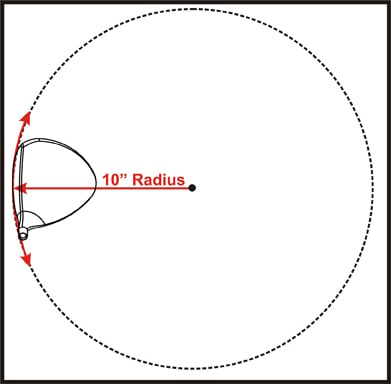
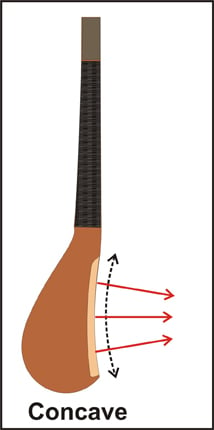 A Brief History of Face Curvature
A Brief History of Face Curvature
It is important to understand that over the 500 or so year’s golf has existed, there have been numerous experiments conducted to create the perfect golf club. Look through golf history books you can find plenty of clubs early on with concave or “hooked” faces. Yes, that’s right! This is just the opposite of what you find today.
These were called “long nose” clubs as they were long and skinny by today’s standard. Look closely at the diagram and notice the direction of the red arrows. In the center of the face the arrow points straight ahead. The heel area of the face now points more toward the target due to the face curvature, whereas the face out near the toe directs back to the center. At first glance this would sound like a plausible way of redirecting a shot hit off center back toward the intended target line, but a closer look shows it is not.
In 1888, Henry Lamb introduced a new type of club that was shorter from heel-to-toe and broader from face-to-back. More importantly the clubhead possessed a reversed face curvature that pointed outward in a convex manner. These clubs would become called “bulger” clubs and changed the shape of clubs used to this date. Even today, written in the Rules of Golf, Appendix II, 5a states that the face of the club…”must not have any degree of concavity.”
Concept of Gear Effect
Contrary to common belief, the clubhead at impact will rotate around its center of gravity (CG), and not around the shaft’s axis. There have been countless experiments with high speed photography over the years to show this is indeed true. At impact, if the ball is aligned directly in-line with the clubhead’s CG, then no sideways twist will occur. However, golf is a game of misses. Hit the ball near the toe and you can feel the club twist open in your hands. Impact toward the heel, low or high on the face of the club and you get an entirely different feel.
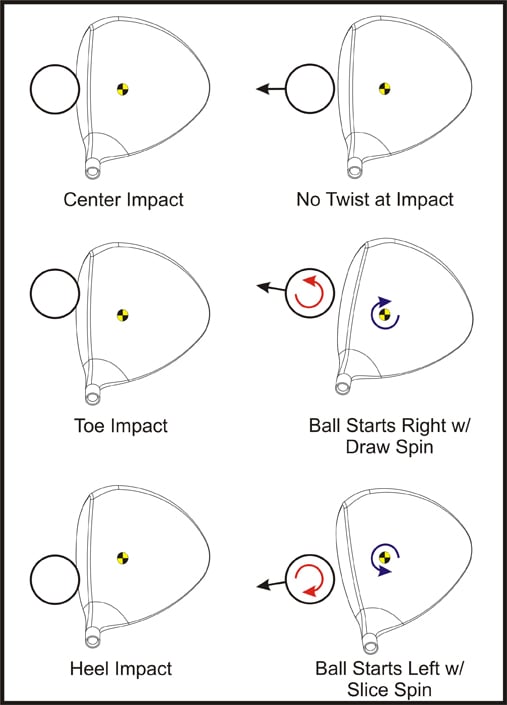 So what exactly happens at impact? We will talk about the bulge first. Take a quick moment to examine the diagram. As we stated before if the ball impacts the face directly in-line with the clubhead’s CG, then no sideways twist will occur and the ball will go straight from where the face is pointing. If the impact is made toward the toe of the club the ball will start to go out to the right (for a right handed club) due to the bulge. In additional, surprisingly a draw spin will be imparted to the ball. This phenomenon is called the gear effect.
So what exactly happens at impact? We will talk about the bulge first. Take a quick moment to examine the diagram. As we stated before if the ball impacts the face directly in-line with the clubhead’s CG, then no sideways twist will occur and the ball will go straight from where the face is pointing. If the impact is made toward the toe of the club the ball will start to go out to the right (for a right handed club) due to the bulge. In additional, surprisingly a draw spin will be imparted to the ball. This phenomenon is called the gear effect.
When two gears work in unison, one gear travels in one direction and the secondary gear moves in the opposite direction. Imagine the bottom gear being the head. As impact occurs at the toe, the gear turns clockwise. Therefore the ball leaves the face with a draw or also called hook spin.
If impact between the ball and clubface occurs toward the heel, then the reverse occurs. The clubface rotates around its center of gravity in a counter-clockwise motion. The ball leaves the face left of the target (again a right-handed head) due to the bulge, but the gear effect provides a slice spin to the ball.
Determining the Correct Amount of Face Curvature
After the “bulger” clubs became the norm, the amount of face curvature incorporated in the design was most likely selected by trial and error or simply how good the club looked at address. But in 1941, John Baymiller and Robert Vose of A.G. Spalding Bros. Inc. received a patent (2,395,837) on clubhead design to minimize the ball flight dispersion from hitting out near the heel or toe of the face of a golf club. Through their extensive testing, they found a correlation suggesting the proper amount of bulge on the face, depending upon how far back the center of gravity was within the head.
This is the very reason why irons and certain hybrids on the market do not have face curvature – simply because the center of gravity is not far enough behind the face to create gear effect.
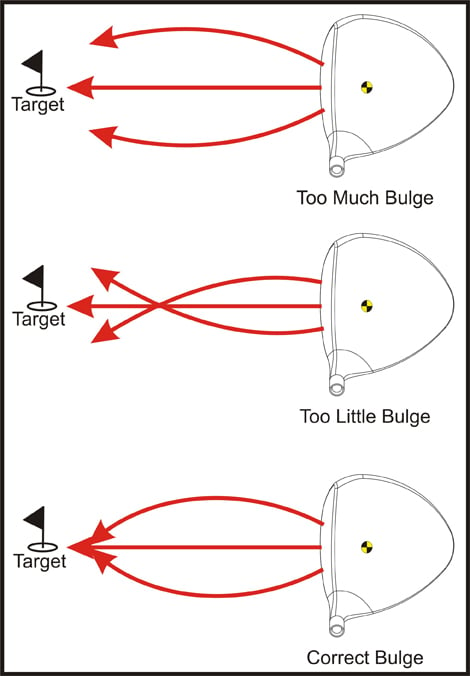 Too much bulge and there is not enough correction. That is, if the ball is struck out near the toe the ball will start out too far right (right hand club) where the draw spin will no longer bring it back toward the target line. Conversely a heel shot will start out too much left and the ball will not have enough slice spin to bring it closer to the target.
Too much bulge and there is not enough correction. That is, if the ball is struck out near the toe the ball will start out too far right (right hand club) where the draw spin will no longer bring it back toward the target line. Conversely a heel shot will start out too much left and the ball will not have enough slice spin to bring it closer to the target.
Too little bulge is just the opposite where there is an over-correction. For example, if the shot is struck out on the toe, the ball won’t start far enough to the right so when it draws back that is will go to the left of the target.
The right amount of bulge will minimize the dispersion from the target and come close to reproducing the results of an impact in-line with the club’s center of gravity. Remember there is a certain amount of energy loss from an off-center impact so one will never totally get the same amount of distance as a center shot. The depth of the center of gravity controls the gear effect and the bulge provides the compensation. The further back the CG is away from the face, the greater amount of face curvature is required.
Vertical Roll
In much the same way bulge works in the heel-to-toe (horizontal) plane, roll works in the sole-to-crown (vertical) plane. The amount roll helps to correct the launch angle for shots hit high or low on the face relative with the center of gravity. Remember that the measured loft will vary on the face with any club with roll. Take a quick moment to examine the following diagram.
The first thing to understand is back spin will occur because of the loft of the club. This occurs regardless if the ball is hit in the center or high or low on the face. Now, let’s take a moment to explain each scenario.
Unlike the bulge where there is no clubhead sideways rotation when the ball is struck line with the horizontal center of gravity, the clubhead will experiences a slight downward force when struck in the same plane as the vertical center of gravity. This causes the clubhead to rotate in a clockwise motion (as pictured). This phenomenon called the vertical gear effect imparts an opposite spin (back spin in this case) to the ball, which is added on top of the back spin provided by the dynamic loft at impact.
If the impact is made lower on the clubface relative to the center of gravity then the clubhead will de-loft or rotate clockwise even more now. Roll curvature comes into play here. That, more than head rotation, is the cause for the lower launch angle. More back spin than before is imparted due to the vertical gear effect. This additional spin creates lift to the ball to help maximize trajectory and distance.
 If impact between the ball and clubface occurs higher on the clubface relative to the center of gravity then the reverse occurs. The clubface rotates around its center of gravity in a counter-clockwise motion (as shown). The ball leaves the face at a higher launch angle, which is important. The vertical gear effect produces a top spin to the ball. Well, it is not really top spin because the spin produced by the loft is much greater, but the top spin is added to the back spin to essentially create reduced back spin. Without the added loft from the roll, the distance would be reduced as less spin usually means less carry.
If impact between the ball and clubface occurs higher on the clubface relative to the center of gravity then the reverse occurs. The clubface rotates around its center of gravity in a counter-clockwise motion (as shown). The ball leaves the face at a higher launch angle, which is important. The vertical gear effect produces a top spin to the ball. Well, it is not really top spin because the spin produced by the loft is much greater, but the top spin is added to the back spin to essentially create reduced back spin. Without the added loft from the roll, the distance would be reduced as less spin usually means less carry.
Seldom will one strike the ball directly in line with the center of gravity in either the vertical or horizontal planes. Therefore you will experience both a certain amount of backspin and side spin. The amount will be determined by the quadrant on the face and how far impact is made in relationship to the center of gravity.
Spin Zone
In the diagram, the small yellow dot represents the location of the center of gravity. No side spin will occur upon impact in this location but there will be back spin due to the loft of the club. Impact anywhere in the red zone will produce draw spin and reduced back spin compared to that with the impact in the yellow. The blue zone will produce slice spin and reduced back spin. The green zone will produce draw spin and increase back spin compared to the yellow impact area. Lastly, the purple zone will produce both increased back spin and slice side spin.
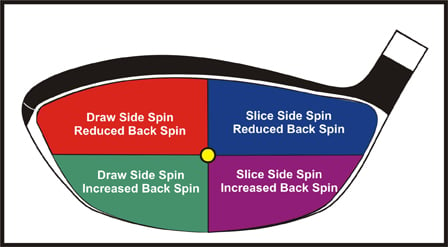 One word of note, the center of the face is not necessarily the location of the center of gravity. We will discuss this in more detail when we discuss “draw biased” clubheads in a separate article. Lastly, because of the manufacturing processes there will be a slight tolerance of +/-1” to face bulge and roll. For instance if the specification is 10”, then radius could be anywhere from 9” to 11” and be within tolerance. But this is well within the limits not to unduly influence the ball flight but could explain why one might like one club over another even though they are supposed to be identical in all other aspects.
One word of note, the center of the face is not necessarily the location of the center of gravity. We will discuss this in more detail when we discuss “draw biased” clubheads in a separate article. Lastly, because of the manufacturing processes there will be a slight tolerance of +/-1” to face bulge and roll. For instance if the specification is 10”, then radius could be anywhere from 9” to 11” and be within tolerance. But this is well within the limits not to unduly influence the ball flight but could explain why one might like one club over another even though they are supposed to be identical in all other aspects.
If you want to know a lot more about gear effect but were afraid to ask, here is a link to Dave Tutelman’s site that explains gear effect in much greater detail. A word to the weary – it is filled with lots of mathematics and physics, but this is the most comprehensive piece on the subject found on the internet.
< To learn more about golf club technology, make sure to buy the Modern Guide to Golf Clubfitting

